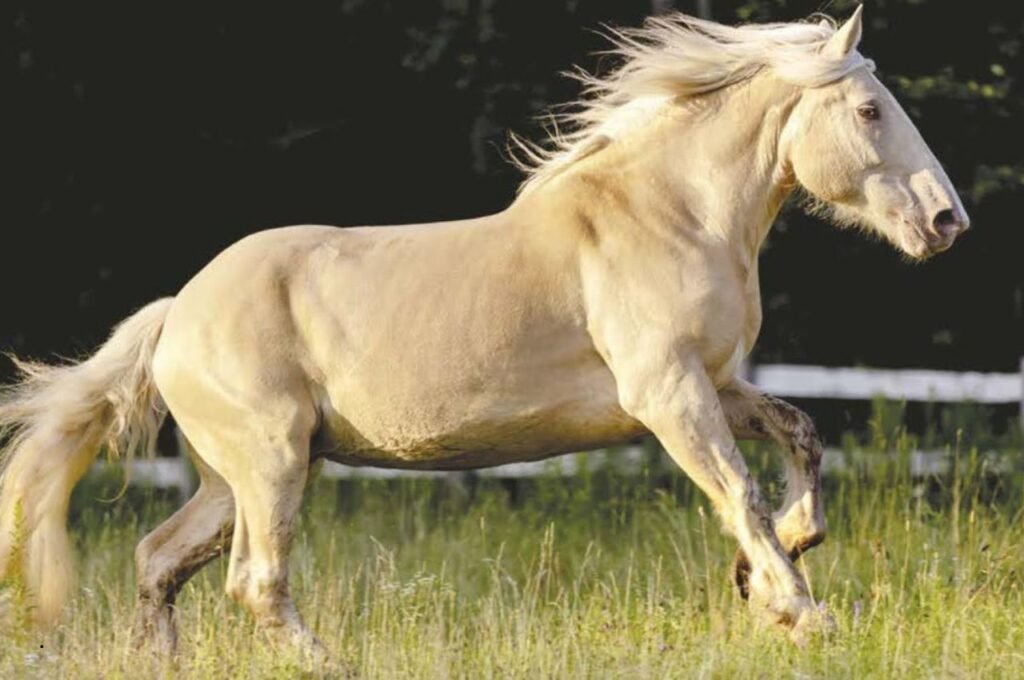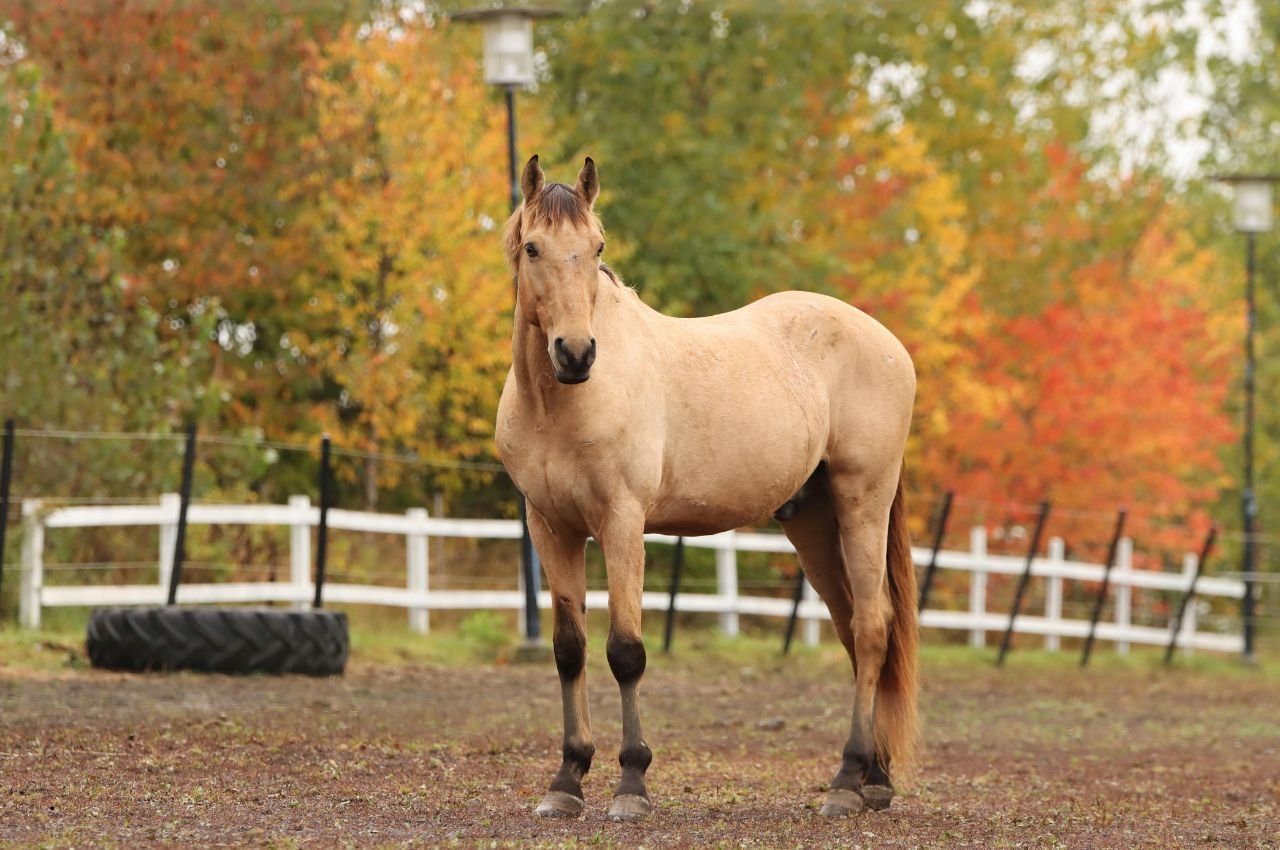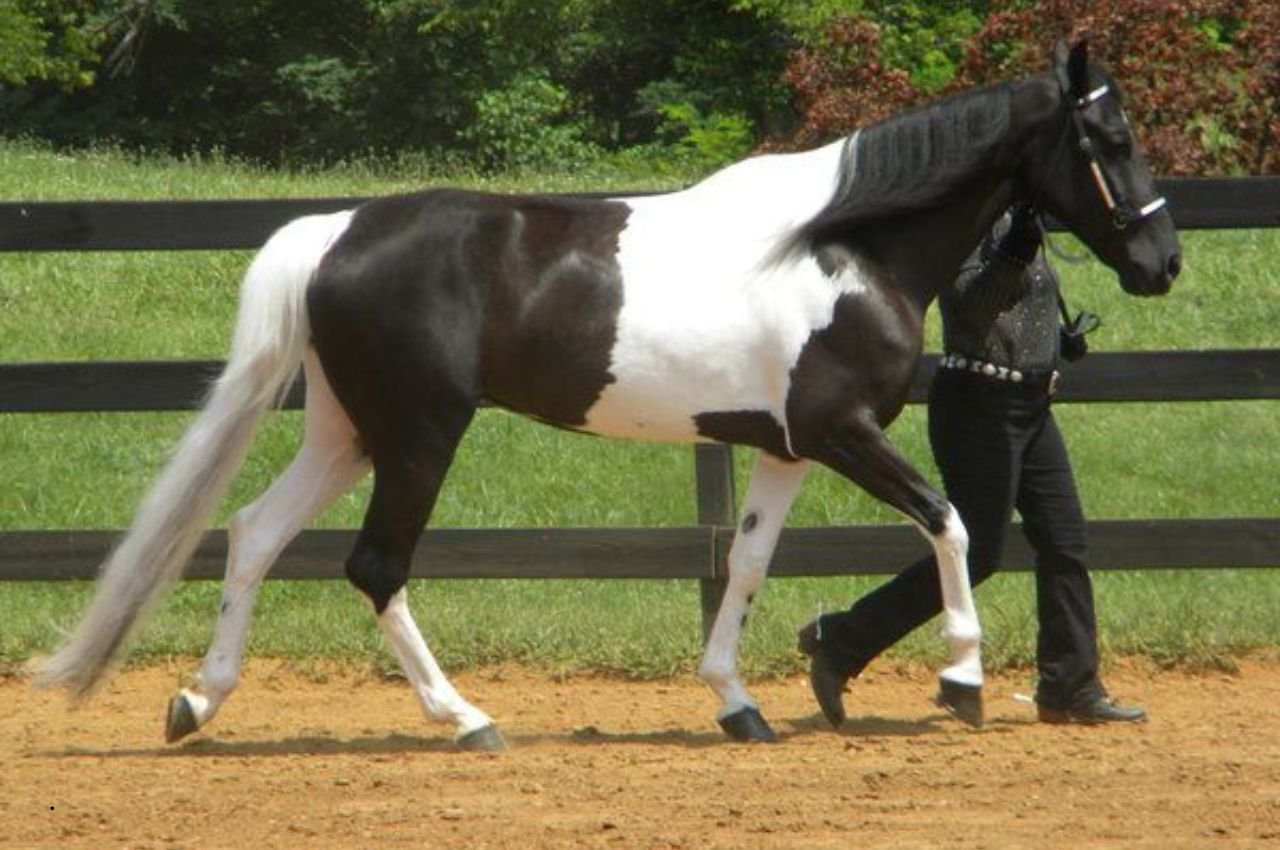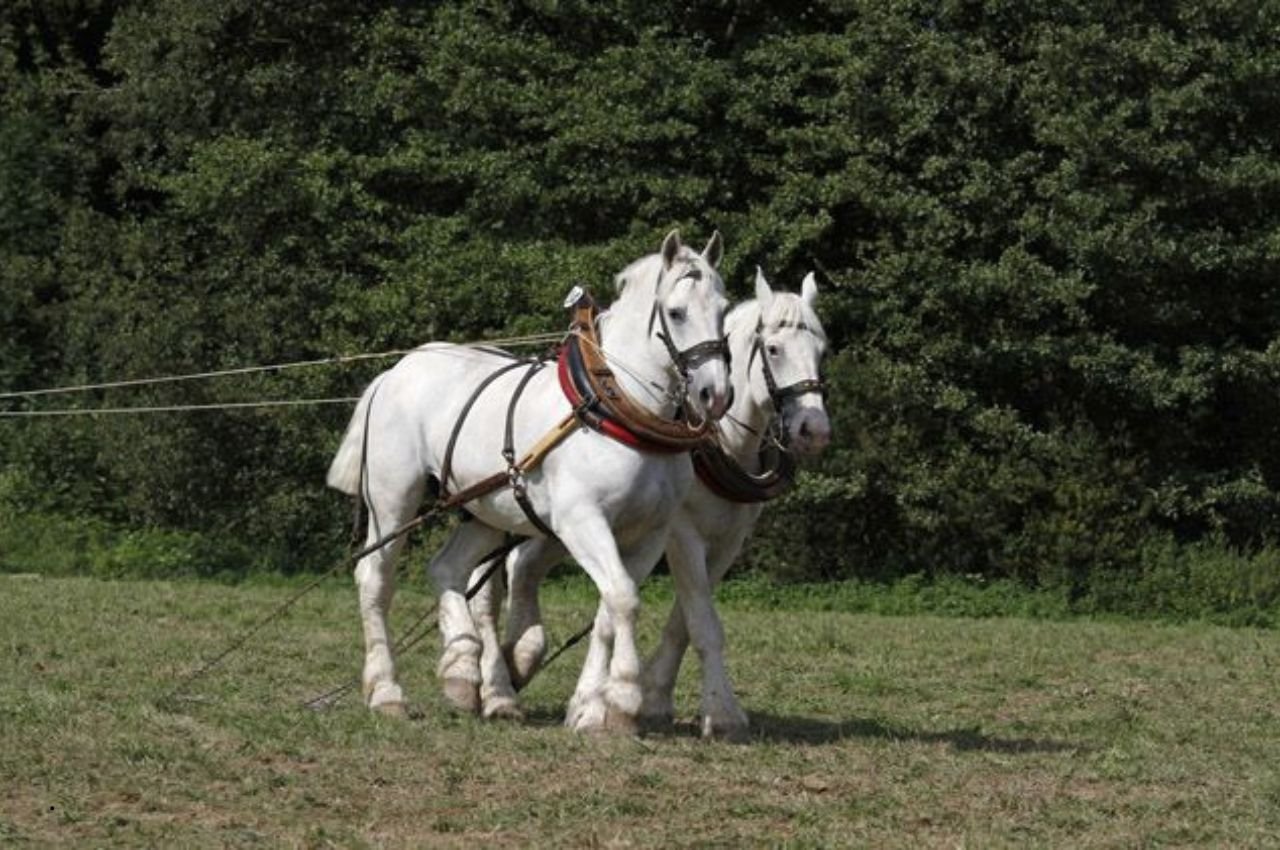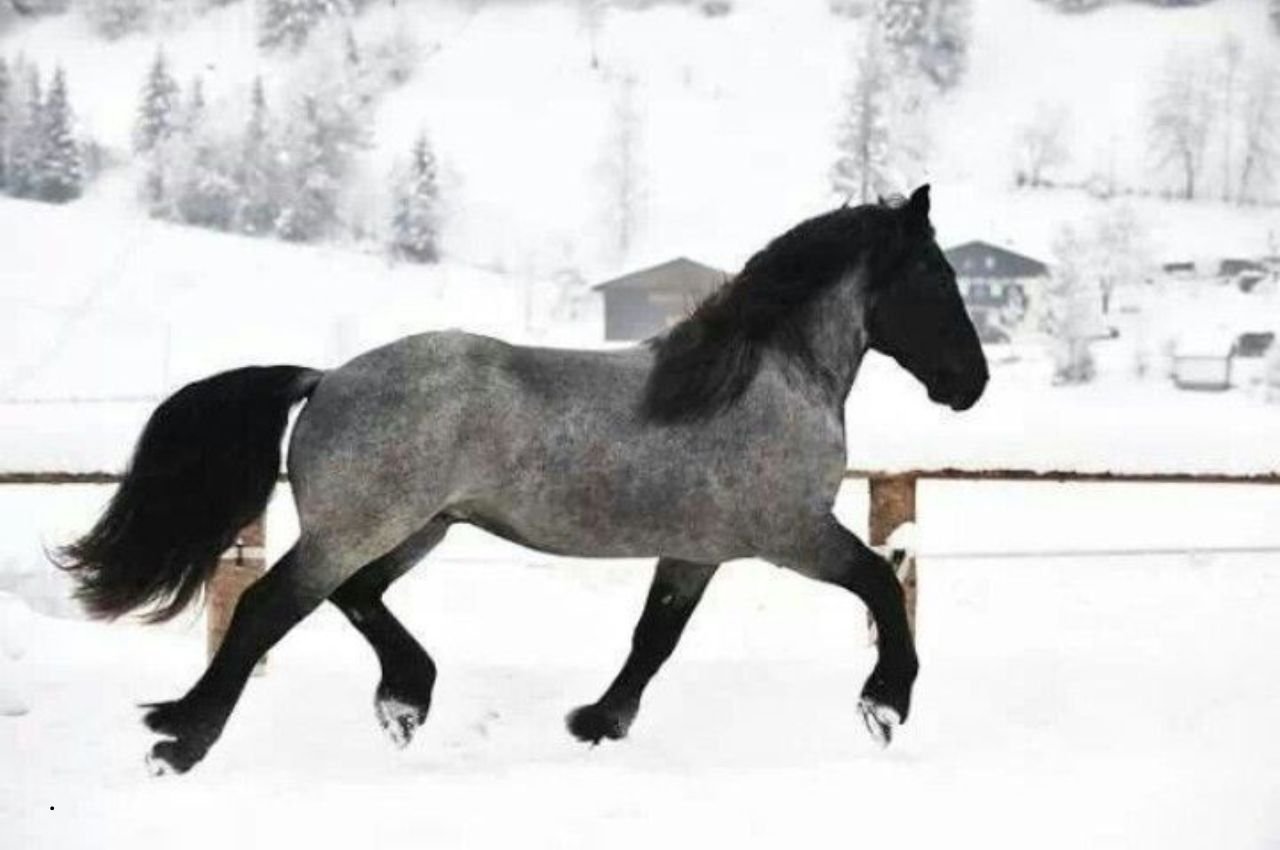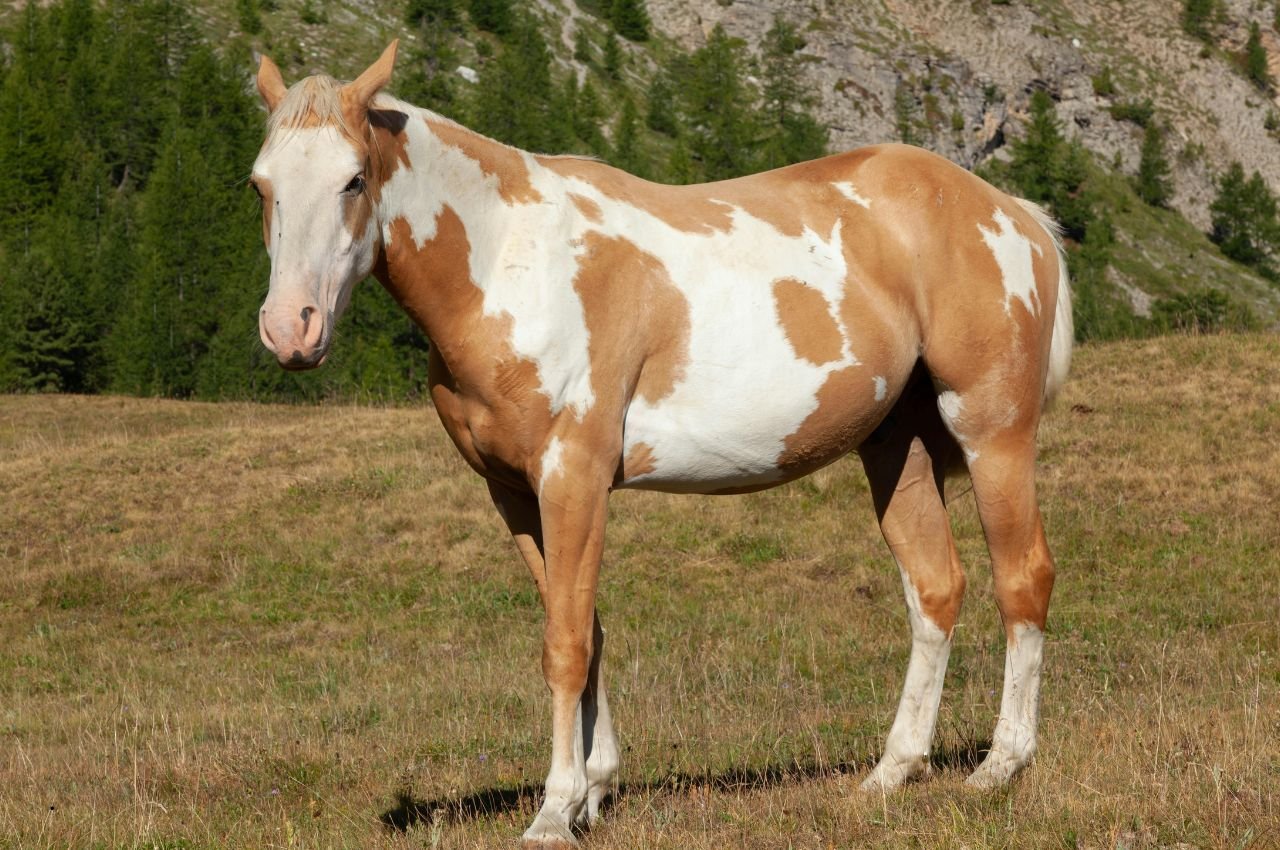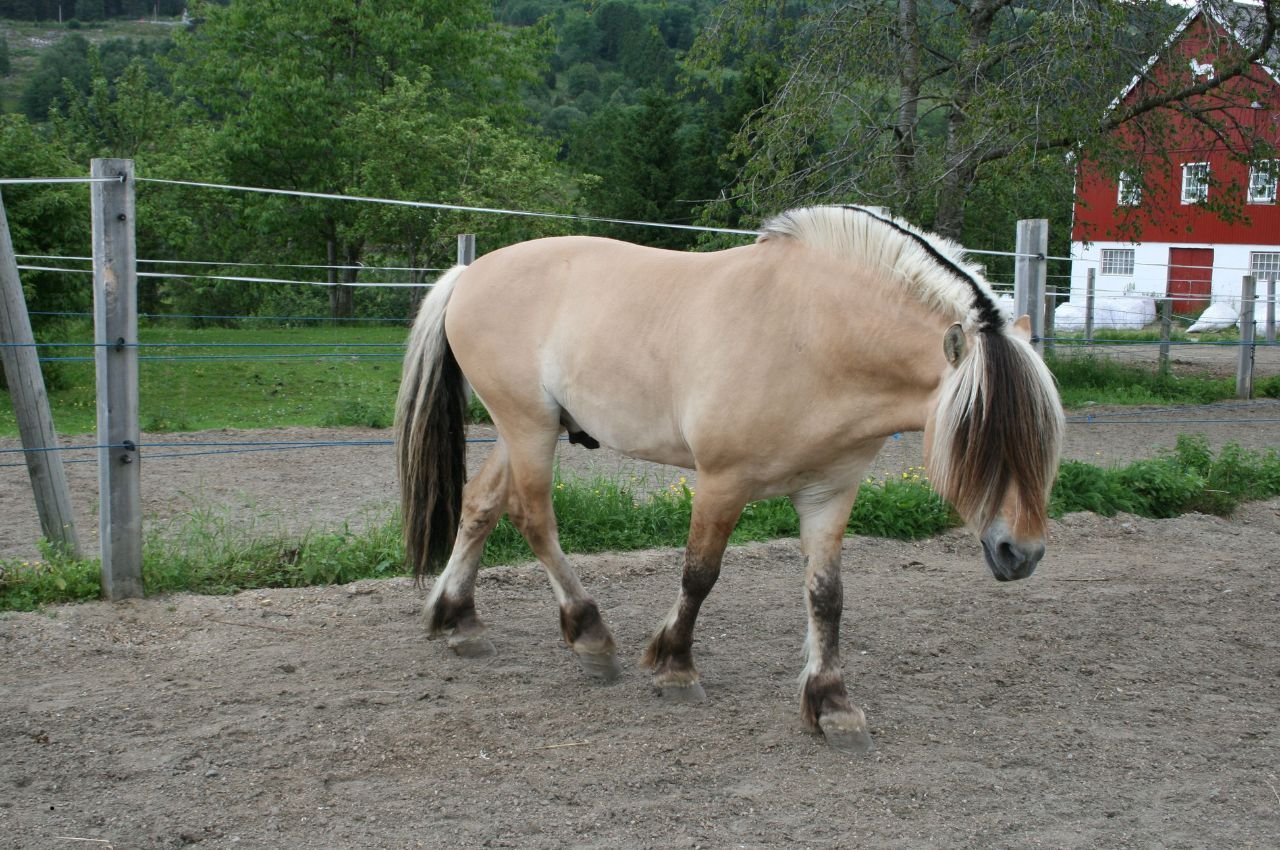The American Cream Draft Horse stands as America’s only native draft breed, representing a unique and precious heritage that nearly disappeared in the mid-20th century. A cream coat and a white mane and tail are the American Cream’s most unique characteristics, creating a stunning visual appearance that immediately distinguishes them from all other draft horse breeds. It is a rare breed: its conservation status is considered critical by The Livestock Conservancy and the Equus Survival Trust, making every individual precious for breed preservation.
What truly sets the American Cream apart from other heavy horses is not just their distinctive beauty but their remarkable origin story. The American Cream draft horse originated in Iowa in the early 1900s, developing from a single foundation mare into a breed that embodies American agricultural heritage. Known for their “gold champagne coat color,” American Cream Drafts are a medium-heavy draft breed, standing 15 to 16.3 hands high, providing the substance necessary for work while maintaining exceptional beauty and gentle temperament.
Historical Development and Foundation
The American Cream Draft’s development represents one of the most remarkable stories in equine breeding history, emerging from a single mare to become America’s only native draft breed. The breed’s foundation mare, a draft horse named Old Granny, was born in Iowa in the early 1900s, establishing the genetic foundation for this unique breed.
Old Granny and Early Development
Their story begins with a horse named Old Granny, a mare auctioned at a farm sale in Story County, Iowa. This remarkable mare possessed the distinctive cream coloring and champagne gene that would define the breed. “Old Granny”, a foundation mare carrying the ‘champagne’ gene, passed unique traits and coat colour that became known as “champagne gold”.
The early development of the breed relied on farmers and breeders who recognized the value of Old Granny’s unique characteristics and worked systematically to preserve and enhance them through selective breeding programs. These pioneer breeders established the foundation for what would become the American Cream Draft Horse.
The breed’s development during the early 20th century coincided with the peak of horse-powered agriculture in America, when draft horses were essential to farm operations throughout the Midwest. The American Cream’s practical working ability combined with their distinctive appearance made them popular among farmers who appreciated both function and beauty.
Breed Recognition and Registry Formation
The establishment of a formal breed registry in 1944 marked an important milestone in the breed’s development, providing official recognition and standards that would guide breeding programs. The American Cream Draft Horse Association was formed to maintain breed integrity and promote these unique horses.
However, the mechanization of American agriculture in the mid-20th century brought devastating challenges to all draft horse breeds. The American Cream, as the rarest and most recently developed breed, faced near-extinction as tractors replaced horses on farms throughout the country.
Near Extinction and Revival
The breed registry became inactive for several decades when breed numbers dropped precipitously due to mechanization. By the 1950s and 1960s, American Cream Draft horses had become so rare that their survival was seriously questioned by equine conservationists.
The breed’s salvation came through dedicated enthusiasts who recognized the historical and genetic importance of preserving America’s only native draft breed. The registry was reactivated in 1982, marking the beginning of systematic conservation breeding efforts that continue today.
Modern Conservation Status
It is a rare breed: its conservation status is considered critical by The Livestock Conservancy and the Equus Survival Trust. This critical status reflects the ongoing challenges facing the breed, with population numbers that remain dangerously low despite decades of conservation efforts.
Modern breeding programs focus on maintaining genetic diversity while preserving the distinctive characteristics that define the breed. Every American Cream Draft horse represents precious genetic material essential for the breed’s long-term survival and the preservation of American agricultural heritage.
Physical Characteristics and Distinctive Beauty
The American Cream Draft’s physical appearance combines the substance and strength expected of draft horses with a unique and stunning coloration that makes them immediately recognizable. The American Cream Horse has amber or hazel eyes, a cream coat, pink skin that is prone to sunburn, and a white mane and tail, creating a distinctive appearance unlike any other breed.
The Champagne Gene and Color
The breed’s distinctive coloring results from the champagne gene, a genetic modifier that creates the characteristic cream or gold champagne color. “Old Granny”, a foundation mare carrying the ‘champagne’ gene, passed unique traits and coat colour that became known as “champagne gold”, establishing this trait as the defining characteristic of the breed.
The champagne gene affects not only coat color but also creates the breed’s characteristic amber or hazel eyes and pink skin. This genetic combination produces a range of cream shades from light to medium gold, all with the distinctive sheen that gives the breed its name. Understanding the genetics of coat color helps breeders maintain this unique characteristic.
Unlike some color dilutions, the champagne gene in American Creams produces a consistent, recognizable phenotype that breeds true when two champagne parents are mated. This genetic stability has been crucial for maintaining breed identity and recognition.
Size and Build Specifications
Known for their “gold champagne coat color,” American Cream Drafts are a medium-heavy draft breed, standing 15 to 16.3 hands high. This breed typically stands between 15-16.3 hands, with mares weighing 1600-1800 pounds, and stallions and geldings ranging from 1800-2000 pounds.
This size range places them in the medium draft category, larger than light draft breeds but more moderate than giant breeds like Shires or Clydesdales. Their moderate size provides substantial pulling power while maintaining versatility for various applications.
Conformation and Structure
American Creams have refined heads, with flat facial profiles that are neither concave nor convex. They have wide chests, sloping shoulders and short, strong backs. This balanced conformation reflects breeding for both beauty and functional working ability.
The breed’s head is proportionate and expressive, showing the refinement that distinguishes them from heavier draft types. Their intelligent eyes and alert expression reflect the calm, sensible temperament that makes them excellent working and family horses.
Their body structure emphasizes strength and endurance, with well-sprung ribs providing good heart and lung capacity, strong backs capable of carrying substantial loads, and powerful hindquarters that provide pulling power. The overall impression is one of balanced power combined with elegance.
Legs and Movement
American Cream Drafts typically show clean legs with moderate feathering, distinguishing them from heavily feathered breeds while maintaining the draft horse appearance. Their legs display substantial bone appropriate to their size, with clean joints and well-formed hooves that support soundness and longevity.
Their movement is characterized by free, easy gaits that cover ground efficiently without the exaggerated action of some show draft breeds. This practical, ground-covering movement reflects their heritage as working horses valued for efficiency and stamina.
Special Care for Pink Skin
The American Cream Horse has amber or hazel eyes, a cream coat, pink skin that is prone to sunburn, and a white mane and tail. The pink skin characteristic of the champagne gene requires special management considerations that distinguish American Creams from other draft breeds.
Sunburn prevention becomes particularly important for American Creams, requiring protective measures including shade availability, fly masks with UV protection, and potentially sunscreen application on particularly sensitive areas. This management consideration is essential for maintaining health and comfort, particularly during summer months.
Temperament and Character Traits
The American Cream Draft combines the gentle, willing temperament characteristic of good draft horses with intelligence and adaptability that make them suitable for diverse applications. Originating in the early 20th century, the American Cream Draft is celebrated for its calm demeanor and strong work ethic, making it a versatile horse for farming, show, and recreational purposes.
Mental and Emotional Characteristics
Calm; willing to work; light draft breed; unique coloring with cream colored body and amber eyes accurately captures the breed’s essential temperament traits. American Creams are known for their even temperament, making them suitable for handlers of varying experience levels.
Their intelligence manifests in quick learning ability and adaptability to various situations. This cognitive ability makes them excellent candidates for diverse training programs, from traditional draft work to modern recreational applications.
American Creams typically display the steady, reliable temperament that made draft horses valuable family partners on American farms. Their calm nature doesn’t indicate lack of energy but rather reflects confidence and sensible responses to their environment.
Work Ethic and Cooperation
The American Cream Draft is celebrated for its calm demeanor and strong work ethic, combining willingness to work with the patience necessary for sustained agricultural labor. This work ethic stems from generations of selection for horses that could reliably perform farm duties while remaining safe around families.
Their cooperative nature makes them particularly valuable for teamwork, both with other horses and with human handlers. This cooperation reflects breeding for horses that could work effectively in various agricultural situations while remaining manageable and predictable.
Modern American Creams maintain this traditional work ethic, approaching tasks with enthusiasm while remaining steady and reliable. Their willingness to please makes them rewarding partners for various applications from sustainable farming to recreational driving.
Adaptability and Versatility
With its creamy coat, powerful physique, and calm nature, this breed has earned a place in many barns and farms across the United States. Despite being a rare breed, it has a rich history and plays a vital role in various types of work, from farming to horse shows.
Modern American Cream Drafts demonstrate remarkable adaptability to contemporary applications beyond their traditional farm work origins. Their moderate size and gentle temperament make them suitable for educational programs, therapeutic riding, competitive driving, and various recreational uses.
This unique beauty is also popular with spectators at horse shows, demonstrating their appeal extends beyond working ability to include their distinctive appearance and showmanship qualities.
Health Considerations and Management
American Cream Draft horses require health management that addresses both general equine health needs and considerations specific to their champagne coloring and draft horse size. Understanding these requirements is essential for maintaining optimal health and longevity.
General Health Strengths
The breed generally displays good health and hardiness when properly managed, with their moderate size compared to giant draft breeds reducing some health risks associated with extreme size. Their American farm horse heritage has created animals with practical hardiness suited to varied conditions.
American Creams typically enjoy good longevity when provided with appropriate care, often remaining sound and productive well into their late teens or twenties. Their efficient metabolism and generally sound structure contribute to overall wellness throughout their lives.
Skin and Eye Care Requirements
The American Cream Horse has amber or hazel eyes, a cream coat, pink skin that is prone to sunburn, and a white mane and tail. The pink skin requires vigilant sun protection to prevent painful sunburn and potential long-term skin damage.
Sun protection strategies should include:
- Providing adequate shade during peak sun hours
- Using UV-protective fly masks and sheets
- Applying equine sunscreen to particularly vulnerable areas
- Managing turnout schedules to minimize sun exposure during intense periods
- Monitoring for signs of sun damage or discomfort
The amber or hazel eyes may be more sensitive to bright sunlight than darker eyes, potentially requiring additional protection through fly masks with eye coverage during sunny conditions.
Common Draft Horse Health Issues
Like other draft horses, American Creams may be susceptible to conditions common in large horses including chronic progressive lymphedema, though the incidence varies among bloodlines and with management practices.
Equine polysaccharide storage myopathy (EPSM) can affect draft breeds, requiring dietary management and regular exercise to prevent muscle stiffness and discomfort. Low-carbohydrate diets often help manage this condition.
Joint health monitoring becomes important for working horses, as their size and weight place additional stress on joints and supporting structures. Regular assessment helps identify problems before they become serious.
Preventive Health Care
Comprehensive preventive veterinary care should include:
- Regular health examinations tailored to draft horse needs
- Appropriate vaccination programs based on local disease risks
- Consistent dental care to ensure proper feed utilization
- Systematic parasite management programs
- Regular hoof care from farriers experienced with draft horses
Reproductive health management takes on particular importance for breeding stock in this critically endangered breed, with every successful breeding contributing to conservation efforts.
Exercise and Conditioning
Regular exercise programs help maintain muscle tone, cardiovascular health, and mental well-being while preventing problems associated with inactivity in large horses. American Creams benefit from consistent activity whether through work, driving, or recreational riding.
Conditioning protocols should be tailored to individual horses’ intended uses while building fitness gradually to prevent injury. Their willing nature requires monitoring to prevent overwork, particularly during hot weather when their pink skin may increase heat sensitivity.
Nutritional Requirements and Feeding Management
Proper nutrition forms the foundation for maintaining American Cream Draft horses in optimal condition. Like other large breeds, American Cream Draft Horses require a balanced diet of fiber and nutrients. This usually includes hay, grass, and a small amount of grain, depending on their activity level.
Basic Feeding Principles
Feeding is crucial for the American Cream Draft Horse’s health and growth. A balanced diet includes quality hay, grains, and necessary supplements. Hay should be the primary component, providing essential fiber for digestion. Grains like oats or barley can be included to meet energy needs.
American Cream Drafts typically require 2-2.5% of their body weight in total feed daily, with the majority coming from quality forage. For a 1,700-pound mare, this translates to approximately 34-43 pounds of feed daily, with at least 25-30 pounds from hay or pasture.
Their moderate size compared to giant draft breeds means they often require less absolute feed quantity than larger breeds while still needing nutrient-dense feeds to support their substantial frame and potential work demands.
Forage Quality and Management
High-quality hay forms the nutritional foundation, with timothy hay, orchard grass, and mixed grass hays providing excellent base nutrition. Legume hays like alfalfa can supplement protein and calcium needs but should be balanced with grass hays.
Pasture management requires attention to both nutritional needs and sun protection requirements. Providing shade in pastures becomes essential for pink-skinned horses, potentially requiring artificial shade structures in open areas.
This usually includes hay, grass, and a small amount of grain, depending on their activity level, emphasizing that concentrate needs vary based on individual workload and body condition.
Energy and Concentrate Requirements
Working American Cream Drafts may require additional energy from concentrate feeds, though their moderate size means requirements are typically less than giant draft breeds. Grain feeds should be introduced gradually and fed in multiple daily meals.
For horses susceptible to EPSM, high-fat, low-starch feeds may be beneficial. Fat supplements like rice bran or vegetable oil can provide additional calories without excessive starch.
Commercial feeds designed for draft horses or moderate-energy formulations typically work well for most American Creams, with feeding rates adjusted based on individual metabolism and work demands.
Special Nutritional Considerations
Consistent access to clean, fresh water remains essential, with daily requirements typically ranging from 30-45 gallons depending on weather, work level, and diet. Automatic waterers or large tanks help ensure adequate intake.
Vitamin and mineral supplementation should address potential deficiencies in local feeds while supporting the increased demands of draft horse size. Copper supplementation may be particularly important for maintaining the champagne coat color and overall health.
Body condition monitoring helps ensure feeding programs maintain optimal weight while preventing obesity or undernourishment. Regular assessment allows for feeding adjustments based on seasonal changes, work demands, and individual needs.
Feeding for Conservation Breeding
Breeding stock nutrition takes on particular importance in critically endangered breeds. Proper nutrition supports reproductive success, healthy foal development, and the maintenance of breeding animals in optimal condition for long-term productivity.
Growing American Cream horses require balanced nutrition supporting healthy development without promoting excessive growth rates that might predispose to developmental orthopedic disease. Weanling and yearling feeding should emphasize quality over quantity.
Conservation Status and Breeding Challenges
The American Cream Draft’s conservation status represents one of the most critical situations among American heritage breeds. It is a rare breed: its conservation status is considered critical by The Livestock Conservancy and the Equus Survival Trust, reflecting the urgent need for conservation efforts and responsible breeding programs.
Current Population Status
Population numbers remain dangerously low despite decades of conservation work since the registry’s reactivation in 1982. The breed’s critical status means that every individual American Cream represents precious genetic material essential for breed survival.
Population monitoring by The Livestock Conservancy and breed organizations helps track breeding success and genetic diversity within the small population. These assessments guide conservation strategies and breeding recommendations.
The limited gene pool creates challenges for maintaining genetic diversity while preserving breed characteristics. Genetic testing helps breeders make informed decisions about matings that maximize diversity while maintaining type.
Breeding Program Challenges
The small population size creates inherent challenges for conservation breeding programs. Breeders must balance genetic diversity concerns with maintaining the distinctive champagne coloring and draft horse type that define the breed.
Inbreeding coefficients must be carefully managed to prevent the negative effects of inbreeding depression while recognizing that some level of relationship between breeding animals is inevitable in critically endangered populations.
Outcrossing considerations present complex questions for rare breed conservation. While outcrossing might increase genetic diversity, it risks diluting the unique characteristics that make American Creams distinctive and valuable.
Genetic Management Strategies
Modern genetic management programs utilize DNA testing and pedigree analysis to maintain genetic diversity while preserving breed characteristics. Genetic testing services help verify parentage and assess relationships between potential breeding pairs.
Frozen semen programs help preserve genetics from valuable stallions while allowing broader use of superior individuals across geographic distances. This technology becomes particularly valuable in small populations where geographic separation might otherwise limit breeding options.
Embryo transfer technologies allow superior mares to produce more offspring while other mares carry pregnancies, potentially accelerating genetic progress and population growth.
Conservation Breeding Priorities
Conservation breeding programs must prioritize:
- Maintaining genetic diversity within the limited gene pool
- Preserving the champagne color and distinctive appearance
- Supporting functional soundness and working ability
- Promoting even temperament and trainability
- Preventing known health issues through selective breeding
Cooperative breeding programs help coordinate efforts across multiple breeders, ensuring that breeding decisions consider population-wide genetic management rather than individual herd priorities alone.
Management and Housing Requirements
Successful management of American Cream Draft horses requires understanding their specific needs as medium-heavy draft horses with unique skin sensitivity and conservation importance. Their moderate size compared to giant drafts simplifies some management aspects while their pink skin creates special considerations.
Housing and Shelter Systems
American Cream Drafts adapt to various housing systems from simple run-in shelters to elaborate barns, but their pink skin makes adequate shade provision essential. Shelter design should prioritize sun protection, particularly during peak UV hours.
Stall requirements should accommodate their draft horse size, typically needing stalls of 12′ x 12′ minimum with 14′ x 14′ preferred for comfort. Barn design considerations include adequate ceiling height, appropriate ventilation, and door dimensions suitable for their build.
Indoor housing provides valuable sun protection during intense summer months, potentially reducing sunburn risk during peak UV periods. However, horses still require adequate exercise and turnout for physical and mental health.
Pasture Management and Sun Protection
Pasture management for American Creams must balance nutritional needs with critical sun protection requirements. Providing adequate shade becomes non-negotiable for these pink-skinned horses.
Shade options include:
- Natural tree shade in wooded pasture areas
- Artificial shade structures in open fields
- Run-in sheds accessible from pastures
- Strategic turnout scheduling to minimize peak sun exposure
- Use of UV-protective sheets during extended outdoor periods
Rotational grazing helps maintain pasture quality while potentially allowing rotation to more shaded areas during peak sun periods.
Skin Care and Sun Protection
Daily skin care becomes essential for maintaining health and comfort in pink-skinned horses. Regular inspection helps identify sunburn or skin irritation early when treatment is most effective.
Sun protection strategies should include:
- UV-protective fly sheets during turnout
- Fly masks with UV protection for face and eye protection
- Equine sunscreen application on particularly vulnerable areas
- Strategic turnout management to avoid peak UV hours
- Providing multiple shade options in all turnout areas
Daily Care and Grooming
Grooming routines for American Creams should include regular skin inspection for signs of sunburn, irritation, or other dermatological issues. Their white manes and tails require consistent care to maintain cleanliness and prevent staining.
Coat care helps maintain the distinctive champagne coloring while monitoring skin health. Their cream coat may show dirt more readily than darker colors, requiring more frequent grooming to maintain appearance.
Regular hoof care from farriers experienced with draft horses helps maintain soundness and working ability. Their moderate size compared to giant drafts makes hoof work somewhat easier than with larger breeds.
Exercise and Activity Management
Regular exercise programs maintain fitness and mental health while preventing problems associated with inactivity in draft horses. American Creams benefit from consistent activity through work, driving, or recreational use.
These horses need regular exercise to maintain their muscular physique, emphasizing the importance of consistent activity for health maintenance and performance readiness.
Exercise scheduling should consider sun exposure, potentially requiring early morning or evening activities during summer months to minimize UV exposure and heat stress for pink-skinned horses.
Training and Work Applications
American Cream Draft horses respond well to systematic training programs that take advantage of their intelligence, willing temperament, and moderate size. Their versatility allows for diverse applications from traditional draft work to modern recreational uses.
Foundation Training Principles
Ground training forms the essential foundation for all American Cream training programs. Their calm temperament typically makes basic training straightforward, though their size requires clear communication and respect from the beginning.
Basic handling skills including leading, tying, grooming, and basic manners must be thoroughly established. The breed’s intelligence and cooperative nature generally make this foundation training efficient and rewarding.
Young horse development should progress systematically, taking advantage of their willing nature while ensuring proper physical and mental maturation before demanding work begins.
Traditional Draft Work Training
Draft training remains relevant for American Creams, whether for working farms, educational programs, or recreational purposes. Their moderate size makes them more manageable than giant draft breeds while providing substantial working ability.
Harness training typically progresses smoothly with their cooperative temperament. Proper harness fitting ensures comfort and efficient power delivery while preventing equipment-related problems.
Team training takes advantage of their steady temperament and willingness to cooperate with both handlers and other horses. Their calm nature makes them excellent team members for various draft applications.
Driving and Performance Training
Pleasure driving represents a popular application for American Creams, taking advantage of their beautiful appearance and steady temperament. Their distinctive coloring makes them eye-catching in driving competitions and exhibitions.
Combined driving training develops their athletic ability across dressage, marathon, and cones phases. Their moderate size and agility suit them well for this demanding sport.
Show training for halter and performance classes helps promote the breed while demonstrating their quality to potential breeders and enthusiasts. This unique beauty is also popular with spectators at horse shows.
Specialized Training Applications
Therapeutic riding programs may benefit from American Creams’ calm temperament and moderate size, though their sun sensitivity requires careful facility management to ensure adequate shade.
Educational programs utilize American Creams to teach about rare breeds, agricultural heritage, and equine genetics, making them valuable ambassadors for heritage breed conservation.
Sustainable farming applications showcase their traditional working ability while supporting breed conservation through demonstrating their continued practical relevance.
Modern Uses and Conservation Applications
Contemporary American Cream Drafts serve diverse roles that demonstrate their continued relevance while supporting conservation through showcasing their versatility and value. Despite being a rare breed, it has a rich history and plays a vital role in various types of work, from farming to horse shows.
Agricultural and Farming Applications
Modern sustainable farming operations increasingly value draft horses for specialized applications. American Creams’ moderate size and efficient movement make them practical for small farm operations and market gardening.
Organic farming systems benefit from their ability to cultivate without soil compaction or chemical inputs, while their distinctive appearance adds value to agritourism operations.
Traditional farming demonstrations showcase historical agricultural methods while maintaining public awareness of American agricultural heritage and rare breed conservation needs.
Show and Exhibition Uses
This unique beauty is also popular with spectators at horse shows, demonstrating their appeal extends beyond working ability to include their stunning appearance and showmanship qualities. Draft horse shows provide venues for exhibiting breed quality while promoting conservation.
Breed exhibitions at agricultural fairs and heritage events help maintain public awareness of American Cream Drafts while educating visitors about rare breed conservation. Their distinctive appearance makes them effective ambassadors for heritage breed preservation.
Driving competitions showcase their athletic ability and trainability while demonstrating that rare breeds can excel in modern performance venues.
Educational and Cultural Applications
Living history programs utilize American Creams to demonstrate traditional American farming methods while preserving knowledge about horse-powered agriculture. Their role as America’s only native draft breed makes them particularly significant for American agricultural heritage programs.
University programs use American Creams to teach equine genetics, rare breed conservation, and sustainable agriculture, providing students with hands-on experience while supporting conservation.
Youth education programs introduce younger generations to rare breed conservation, helping ensure future support for preservation efforts while teaching responsible horse management and breeding practices.
Conservation Breeding Programs
The most critical modern application for American Cream Drafts remains conservation breeding to ensure breed survival. Every breeding decision contributes to either the breed’s recovery or continued endangerment, making responsible breeding practices essential.
Cooperative breeding programs coordinate efforts across multiple breeders to maximize genetic diversity while maintaining breed type. These programs require careful planning and commitment to population-wide conservation goals.
Breed promotion activities help generate interest and support for American Cream Drafts while creating markets for horses that support continued breeding efforts. Public awareness directly impacts the breed’s long-term survival prospects.
Therapeutic and Recreational Uses
Therapeutic riding programs may utilize American Creams where their calm temperament and moderate size suit program needs, though facilities must ensure adequate sun protection for these pink-skinned horses.
Recreational driving allows owners to enjoy their horses while demonstrating their versatility and trainability. American Creams’ beautiful appearance and steady temperament make them excellent pleasure horses.
Trail riding applications showcase their versatility beyond traditional draft work, though activities must consider sun protection needs during extended outdoor exposure.
Frequently Asked Questions (FAQs)
General Breed Information
Q: What makes American Cream Draft horses unique? A: The American Cream draft horse originated in Iowa in the early 1900s, making them America’s only native draft breed. A cream coat and a white mane and tail are the American Cream’s most unique characteristics, created by the champagne gene inherited from their foundation mare, Old Granny.
Q: How rare are American Cream Draft horses? A: It is a rare breed: its conservation status is considered critical by The Livestock Conservancy and the Equus Survival Trust. They are one of the rarest horse breeds in America, with population numbers that remain dangerously low despite conservation efforts.
Q: What size are American Cream Draft horses? A: Known for their “gold champagne coat color,” American Cream Drafts are a medium-heavy draft breed, standing 15 to 16.3 hands high. Mares typically weigh 1600-1800 pounds, while stallions and geldings range from 1800-2000 pounds.
Q: What is the champagne gene? A: The champagne gene is a genetic modifier that creates the breed’s distinctive cream or gold champagne coloring. “Old Granny”, a foundation mare carrying the ‘champagne’ gene, passed unique traits and coat colour that became known as “champagne gold”. This gene also produces amber or hazel eyes and pink skin.
Q: What colors do American Cream Draft horses come in? A: The American Cream Horse has amber or hazel eyes, a cream coat, pink skin that is prone to sunburn, and a white mane and tail. The coat ranges from light cream to medium gold champagne, all with the distinctive champagne gene characteristics.
Care and Management
Q: Do American Cream Draft horses require special care? A: Yes, The American Cream Horse has pink skin that is prone to sunburn, requiring special sun protection measures including shade, UV-protective equipment, and potentially sunscreen. They also need standard draft horse care for their size.
Q: How do you protect American Cream Draft horses from sunburn? A: Sun protection strategies include providing adequate shade, using UV-protective fly sheets and masks, applying equine sunscreen, and managing turnout schedules to minimize peak sun exposure. Multiple protection methods work best.
Q: What housing do American Cream Draft horses need? A: They adapt to various housing systems but require adequate shade provision due to pink skin. Stalls should be at least 12′ x 12′ (14′ x 14′ preferred), with proper ventilation and sun-protected turnout areas.
Q: Are American Cream Draft horses hardy? A: Yes, they display good general hardiness, but their pink skin requires vigilant sun protection to prevent health problems. With proper management, they typically enjoy good longevity and remain sound into their twenties.
Health and Nutrition
Q: What health issues affect American Cream Draft horses? A: Primary concerns include sunburn due to pink skin, and potential susceptibility to conditions common in draft breeds like chronic progressive lymphedema and EPSM. Regular preventive care is essential.
Q: What do American Cream Draft horses eat? A: Like other large breeds, American Cream Draft Horses require a balanced diet of fiber and nutrients. This usually includes hay, grass, and a small amount of grain, depending on their activity level. They typically need 2-2.5% of body weight in total feed daily.
Q: How much do American Cream Draft horses eat per day? A: A balanced diet includes quality hay, grains, and necessary supplements. For a 1,700-pound horse, this translates to approximately 34-43 pounds of feed daily, with at least 25-30 pounds from hay or pasture.
Q: Do American Cream Draft horses have special nutritional needs? A: Beyond standard draft horse nutrition, they may benefit from copper supplementation for coat color maintenance. Horses susceptible to EPSM may require high-fat, low-starch diets. Body condition monitoring helps optimize feeding.
Temperament and Training
Q: What is the temperament of American Cream Draft horses? A: Originating in the early 20th century, the American Cream Draft is celebrated for its calm demeanor and strong work ethic. Calm; willing to work; light draft breed; unique coloring with cream colored body and amber eyes describes their essential character traits.
Q: Are American Cream Draft horses good for beginners? A: Their calm temperament makes them suitable for handlers of varying experience levels, though their size requires basic large horse handling knowledge. Their willing nature and intelligence make them forgiving and easy to work with.
Q: What can American Cream Draft horses be trained for? A: They’re versatile horses suitable for farming, showing, driving, and recreational purposes. Their moderate size and willing temperament make them adaptable to various applications.
Q: How do American Cream Draft horses compare to other draft breeds? A: As a medium-heavy draft breed, they’re more moderate in size than giant breeds like Shires or Clydesdales, making them more versatile and easier to manage while still providing substantial working ability.
Breeding and Conservation
Q: Why are American Cream Draft horses endangered? A: It is a rare breed: its conservation status is considered critical by The Livestock Conservancy and the Equus Survival Trust. Their small population size, combined with mechanization reducing demand for draft horses, brought them to near-extinction.
Q: How can I help conserve American Cream Draft horses? A: Support conservation through responsible breeding if qualified, promoting breed awareness, supporting the American Cream Draft Horse Association, attending breed exhibitions, and choosing American Creams for appropriate applications. Every action supporting the breed aids conservation.
Q: Where can I find American Cream Draft horses? A: Contact the American Cream Draft Horse Association for breeder information. Due to their rarity, finding available horses may require patience and willingness to travel. Supporting responsible breeders aids conservation.
Q: What should I consider before breeding American Cream Draft horses? A: Breeding critically endangered breeds requires serious commitment to conservation goals, understanding of equine genetics, adequate resources for proper mare and foal care, and willingness to make breeding decisions that prioritize breed conservation over personal preferences.
Q: Are American Cream Draft crosses acceptable? A: While crossbreeding may serve individual purposes, it doesn’t contribute to purebred conservation. Given the breed’s critical status, priority should be on producing purebred replacements to ensure breed survival rather than creating crosses.
The Future of American Cream Draft Horses
The long-term survival of America’s only native draft breed depends on continued conservation efforts, responsible breeding practices, and growing public awareness and support. The breed’s critical conservation status means that every decision regarding these horses impacts their future survival prospects.
Conservation Priorities
Immediate conservation priorities include:
- Increasing population numbers through responsible breeding
- Maintaining genetic diversity within the limited gene pool
- Promoting breed awareness to generate support and markets
- Supporting research into breed genetics and health
- Coordinating breeding efforts across geographic regions
- Developing sustainable economic models supporting breed preservation
Population recovery requires coordinated efforts from breeders, breed organizations, conservation groups, and enthusiasts working toward common goals of breed survival and prosperity.
Role of Breed Associations
The American Cream Draft Horse Association plays crucial roles in:
- Maintaining accurate studbooks and pedigree records
- Providing breeding guidance based on genetic management principles
- Promoting the breed through shows, exhibitions, and educational programs
- Supporting research into breed health and genetics
- Coordinating conservation efforts across breeders
- Maintaining breed standards while prioritizing genetic diversity
Collaboration between the ACDHA, The Livestock Conservancy, and Equus Survival Trust ensures comprehensive conservation strategies combining organizational expertise and resources.
Public Awareness and Support
Growing public awareness of American Cream Drafts directly impacts their survival prospects by:
- Creating markets for horses that support continued breeding
- Generating financial support for conservation programs
- Inspiring new breeders to commit to preservation efforts
- Increasing visibility at shows and public events
- Supporting educational programs about rare breeds
- Encouraging appropriate use of these versatile horses
Social media and digital platforms provide powerful tools for promoting breed awareness and connecting enthusiasts worldwide, helping overcome geographic barriers to breed support.
Economic Sustainability
Long-term breed survival requires developing sustainable economic models where breeding and maintaining American Cream Drafts remains financially viable. This includes:
- Demonstrating their value in sustainable agriculture
- Promoting their versatility for multiple uses
- Supporting premium pricing reflecting their rarity and quality
- Developing agritourism opportunities featuring the breed
- Creating markets for their services in various applications
Value-added opportunities that showcase their unique beauty and capabilities help justify the investment required for responsible breeding and maintenance.
Research and Genetic Management
Continued genetic research helps optimize breeding strategies while understanding health issues affecting the breed. DNA testing provides tools for managing genetic diversity and preventing inherited disorders.
Collaborative research between universities, conservation organizations, and breed associations advances understanding of champagne genetics, population dynamics, and optimal conservation strategies.
Conclusion
The American Cream Draft Horse represents an irreplaceable piece of American agricultural heritage, standing as the only draft breed native to the United States. Their distinctive cream coloring, amber eyes, and white manes and tails create a stunning appearance that immediately distinguishes them from all other horses, while their calm temperament and willing nature make them beloved partners for various applications.
The breed’s remarkable origin story – developing from a single foundation mare named Old Granny into a distinct breed – demonstrates the potential for systematic breeding to create unique and valuable horses. Their near-extinction and subsequent revival through dedicated conservation efforts illustrates both the fragility of rare breeds and the power of committed individuals to preserve endangered heritage.
However, the breed’s critical conservation status cannot be overstated. It is a rare breed: its conservation status is considered critical by The Livestock Conservancy and the Equus Survival Trust. Every American Cream Draft horse alive today represents precious genetic material essential for breed survival, making each individual invaluable to conservation efforts.
For those considering American Cream Draft horses, whether for sustainable farming, driving, showing, or conservation breeding, these remarkable horses offer a unique combination of beauty, functionality, and historical significance. Their moderate size makes them more manageable than giant draft breeds while their distinctive appearance and gentle temperament create devoted enthusiasts.
The future of America’s only native draft breed depends on continued support from breeders, enthusiasts, conservation organizations, and the general public. Every person who chooses to support American Cream Drafts through breeding, ownership, promotion, or education contributes directly to ensuring these beautiful horses remain part of America’s living agricultural heritage.
With proper care, including vigilant sun protection for their pink skin, appropriate nutrition, and responsible breeding practices, American Cream Draft horses can continue to serve as both functional working horses and stunning ambassadors for rare breed conservation, embodying the beauty and utility that made them valuable to American farmers for over a century.
The story of the American Cream Draft is far from over – indeed, the most critical chapters are being written today by those who commit to ensuring these remarkable horses survive and thrive for future generations to appreciate and enjoy.
References and Resources
For comprehensive breed information and registration, the American Cream Draft Horse Association serves as the official breed registry and primary resource for breeders, owners, and enthusiasts seeking information about America’s only native draft breed.
Conservation status and population monitoring information can be found through The Livestock Conservancy, which maintains the Conservation Priority List documenting critically endangered American livestock breeds including the American Cream Draft.
Additional conservation resources and support are available through the Equus Survival Trust, which works to protect rare and endangered horse breeds worldwide through education, support, and conservation initiatives.
Historical information and breed development details are available through Oklahoma State University – Breeds of Livestock, which maintains comprehensive documentation of livestock breed history and characteristics.
Modern breed profiles and management information can be found at Mad Barn – Draft Horse Breed Guide, providing contemporary perspectives on care and management for various draft breeds.
Genetic testing services and research into champagne genetics are available through UC Davis Veterinary Genetics Laboratory, offering DNA testing for parentage verification, genetic diversity assessment, and color genetics.
Professional feeding and nutrition guidance for draft horses can be found through Kentucky Equine Research, providing research-based nutritional recommendations.
Training and management resources are available through draft horse organizations and working horse associations that promote traditional skills and modern applications.
Sun protection products and skin care information for horses with pink skin can be found through specialized equine skin care suppliers and UV protection product manufacturers.
Conservation breeding guidance and genetic management principles are available through conservation genetics organizations and rare breed conservation groups working to preserve endangered livestock breeds.

